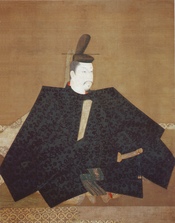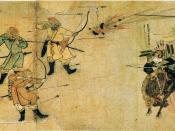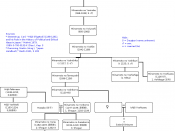FEUDAL JAPAN
TIMELINE
710-794 NARA ERA
794-1156 HEIAN JAPAN
1156-1180 TAIRA RULE (EARLY MILITARY HOUSE)
1185-1333 KAMAKURA BAKUFU
1333-1336 DISPUTED CONTROL
1336-1467 ASHIKAGA BAKUFU
Rise of Feudalism: In contrast to Europe, where feudalism declined as centralized national monarchies grew stronger, in Japan feudal institutions increasingly replaced national ones after the 11th century. Emperors continued to reign, but they no longer ruled. Their power was replaced by that of the provincial lords, who were descended from the old clan lords or court nobility that had left the capital. These lords managed the estates, fought the wars, and supervised the peasant population. Some still acknowledged their patronage to the great court families such as the Fujiwara, and remitted part of their income to them, but as time went on they became less inclined to do so, as they no longer needed protection from the imperial court.
The Economic and Political Structure of Japan encouraged a more decentralized power structure.
Once attempts to establish a Chinese-style tax system were given up, centralized government resorted to fixed quotas, which were collected by the regional authorities, and any amount collected over the quota was kept by the regional authorities. This enhanced power at the local levels. Conscription armies also proved ineffective in Japan, so that the court began a new system based on local mounted warriors, the samurai. They generally came from well-to-do families who could afford the costly armor and equipment. Their initial purpose was to preserve order and help collect taxes, but from 10th century onward they also contributed to the disorder as participants in regional military coalitions.
Rise of the Samurai: By 1200, the Japanese military forces had emerged as potent force for either change or stability. Samurai warriors hailed mainly from local aristocrats, and gave greater influence to provisional strongmen.
Samurai dominated Japanese feudal society. The name samurai came from the verb meaning "to serve." It was expensive to be a warrior, as you had to supply your own armor, horse, and weaponry. Each aristocratic soldier was accompanied by a small band of retainers, clad in light armor of fabric, leather and metal (which worked better than the heavy armor of the European knights). Armed with bows and arrows and curved swords, Japanese warrior aristocrats were called either "samurai" or (lord) or bushi ("noble warrior"). A feudal-style relationship existed between the lord and his samurai; and the samurai often served the same family for generations. It was different from European-style feudalism in that the samurai weren't rewarded by being given estates to run directly -- the system which created medieval Europe's pyramid-style pattern of land ownership. Instead, the lord provided the samurai with income derived from his agricultural estates. In return the samurai was expected to serve his lord with absolute loyalty.
Bushido: was the samurai code of conduct. The samurai held to a highly developed warrior ethic, which stressed personal bravery and prowess, honor and loyalty. It was unique in some of its attributes. It stressed a hard, spartan life and avoidance of luxuries, and expected a samurai to face pain and death with indifference. The warrior code stressed family honor -- much of combat hinged on man-to-man struggles; and samurai warriors would shout out their lineage and exploits before battle. Beaten or disgraced warriors were expected to commit ritual suicide. The Bushido code did not wholly exclude samurai women, who were also expected to be brave and choose death rather than submit to shame.
The rise of the samurai and feudal system thwarted any hope the peasants might have had of improving their status -- over the next several centuries, Japanese peasants were reduced to serfdom, bound to the land and treated as the property of the local lord for whom they worked. They were separated by rigid class barriers from the warrior elite, and forbidden to dress like them, carry swords, or ride on horseback
KAMAKURA PERIOD
In 1185, a shift began from centuries of rule by the civil aristocracy to centuries of rule by military powers. This was the formation of the bakufu style of government, which had no Chinese counterpart whatsoever.
From the 12th century onward, Japanese history was increasingly dominated by civil wars between shifting factions of the court and local warlords. In the 12th century, the fighting culminated in two major wars between rival clans that were both descended from junior branches of the imperial lines -- court nobility who had left the capital early on to make their fortunes in the provinces.
Minamoto was the victor in the fighting. He had the imperial court, after initial resistance, grant him the title of "Barbarian-Quelling Generalissimo," his own creation -- in Japanese, title shortened to "shogun." Shogun became a title military dictators in Japan used until the mid-19th century.
The era, like that of the Nara and Heian, was named for the court: Kamakura was a sea-town near present-day Tokyo -- the shogun wanted to be away from the corrupting influence of a court city. The shogunal dynasty called its government the bakufu ("tent government") to stress its military and non-courtly aspects.
The Kamakura Shogunate lasted for a century and a half. It outlasted the Minamoto line that had established it, although the Minamoto remained rulers in name; another Japanese family, the Hojo, took over by marrying into the Minamoto and then seizing power and ruling through regents. The Shogun was a military leader. At first he was technically serving the emperor, but after 1200, the emperor became a figurehead. By the 13th century, Japan had a puppet emperor, selected and controlled by the Fujiwara clan, a group of civilian aristocrats presiding at Kyoto, while the true power remained in the hands of the Hojo clan's regents.
Mongol Invasions: In the mid-13th century, for the first time in its history, Japan faced an extreme foreign threat -- the Mongol invasions. The Mongols had already conquered or intimidated most of Asia and Europe.
In 1266, Kublai Khan sent envoys to Japan demanding their submission. The emperor was for it, but the bakufu refused. When the Mongols sent a second team of envoys, the Japanese bakufu cut off their heads and sent back the parts as an answer.
In 1274, a force of 25,000 Mongols and their Korean subjects landed in Hakata Bay in Kyushu. The Mongols were accustomed to massed cavalry tactics, but samurai fought in individual combat, and were able to hold them off. After an early, inconclusive battle, the tide turned for the Japanese when a large portion of the Mongol fleet was lost in a storm at sea -- the Mongols lost 1/3 of their forces.
The Bakufu were certain the Mongols would return, and assembled a large fighting force, and built a wall around Hakata Bay.
In 1281, the Mongols returned with a truly huge invasion force -- 140,000 men -- and a huge armada, but the Mongol cavalry was thwarted by the wall, while the small, more easily maneuverable Japanese craft inflicted heavy damage on the larger Mongol ships which were confined in the smallish bay -- a similar military situation to advantage the Classical Greeks had over the Persians fighting units. Then the Japanese got truly lucky as their "divine winds" (kamikaze) returned -- a devastating typhoon wrecked the Mongol fleet; the Mongols lost 60-90% of their men. The Japanese attributed their deliverance to divine intervention. The Mongols, who became distracted with succession problems, never returned, although the bakufu stayed mobilized for two decades just in case.
The Kamikura Bakufu's handling of the Mongol crisis greatly enhanced their prestige, but the practical strains of the long struggle sapped their strength. No spoils were derived from the long defensive war, and many of the samurai found themselves facing financial hardship. Ties that had bound the samurai to the bakufu were wearing thin after several generations. The end of the bakufu came in 1333, when the Hojo family was exterminated by a rival clan, and this action brought the first phase of Japanese feudal age to an end.
Ashikaga Bakufu (1336-1467): between 1331-1336, Japan entered a period of turmoil . They emerged from it with multistate system centered in Kyoto called the Ashikaga Bakufu. The Ashikaga Bakufu was a decentralized state. Each region was controlled by a warrior bands, and civil and military posts were combined, which provided a greater degree of control over the population.
Feudal Era Culture
Cultural forces were also reshaping Japan in the 12th-13th centuries. Japanese Buddhism began to be altered to suit Japanese culture. While the older sects from the Nara and Heian Eras survived, new sects imported from China or native to Japan grew in prominence, which were more suited to the needs of the warrior elite and the ordinary people.
Pure Land Buddhism was introduced from China in the 12th century. Pure Land Buddhists claimed Buddhism's doctrines had become corrupted over time, and the only means to salvation was to put one's faith in the Amida Buddha and call on him for salvation -- faith alone was the path to salvation. This was a more emotional and mystical version, with its simple emphasis on placing one's faith in the Amida Buddha, and was immensely popular, giving hope to the masses.
True Pure Land Buddhism: was a native offshoot of Pure land Buddhism which appeared in the 13th century. It went so far as to repudiate much of the Buddhist doctrines, repudiating clerical celibacy and encouraging clergy to live among the people. True Pure Land claimed that a single instances of someone calling the Buddha's name in sincerity was sufficient for salvation -- the key was humility, since pride could get in the way of opening yourself totally to faith in the Buddha. True Pure Land Buddhism became the largest branch of Buddhism in Japan, followed by Pure Land.
Zen Buddhism: Gained its name from the Japanese pronunciation of Chinese word for meditation, "ChÃÂan." It was introduced into Japan in the end of the 12th century. Zen Buddhism was especially suited to the needs of the samurai because it emphasized simplicity and disciple, rather than scholastic studies, and its stress on hard physical labor to discipline the mind and body reinforced the code of bushido. Thus Zen became the predominant sect of the warrior class of Japan.
The Zen Buddhist religion also helped shape Japanese culture by encouraging a synthesis of the refined attributes of Sung China and the simplicity of design prized by the Japanese aesthetic. This synthesis clearly shown in Japanese tea ceremony, which was developed at this time, a unique type of social intercourse. Another merger of simplicity and refinement, from the Ashikaga period, were the Japanese Nõ Plays, a new kind of dramatic art. These plays stressed very controlled movements and ritualistic manner, and had no counterpart anywhere else in East Asia.


